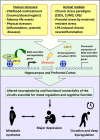New Insights Into the Pivotal Role of CREB-Regulated Transcription Coactivator 1 in Depression and Comorbid Obesity
- PMID: 35242012
- PMCID: PMC8886117
- DOI: 10.3389/fnmol.2022.810641
New Insights Into the Pivotal Role of CREB-Regulated Transcription Coactivator 1 in Depression and Comorbid Obesity
Abstract
Depression and obesity are major public health concerns, and there is mounting evidence that they share etiopathophysiological mechanisms. The neurobiological pathways involved in both mood and energy balance regulation are complex, multifactorial and still incompletely understood. As a coactivator of the pleiotropic transcription factor cAMP response element-binding protein (CREB), CREB-regulated transcription coactivator 1 (CRTC1) has recently emerged as a novel regulator of neuronal plasticity and brain functions, while CRTC1 dysfunction has been associated with neurodegenerative and psychiatric diseases. This review focuses on recent evidence emphasizing the critical role of CRTC1 in the neurobiology of depression and comorbid obesity. We discuss the role of CRTC1 downregulation in mediating chronic stress-induced depressive-like behaviors, and antidepressant response in the light of the previously characterized Crtc1 knockout mouse model of depression. The putative role of CRTC1 in the alteration of brain energy homeostasis observed in depression is also discussed. Finally, we highlight rodent and human studies supporting the critical involvement of CRTC1 in depression-associated obesity.
Keywords: BDNF; CREB; CRTC1; circadian rhythms; major depressive disorder; neuroplasticity; obesity.
Copyright © 2022 Rossetti, Cherix, Guiraud and Cardinaux.
Conflict of interest statement
The authors declare that the research was conducted in the absence of any commercial or financial relationships that could be construed as a potential conflict of interest.
Figures


Similar articles
-
Deletion of CREB-regulated transcription coactivator 1 induces pathological aggression, depression-related behaviors, and neuroplasticity genes dysregulation in mice.Biol Psychiatry. 2012 Oct 1;72(7):528-36. doi: 10.1016/j.biopsych.2012.04.011. Epub 2012 May 15. Biol Psychiatry. 2012. PMID: 22592058
-
Gender-specific alteration of energy balance and circadian locomotor activity in the Crtc1 knockout mouse model of depression.Transl Psychiatry. 2017 Dec 8;7(12):1269. doi: 10.1038/s41398-017-0023-4. Transl Psychiatry. 2017. PMID: 29217834 Free PMC article.
-
The HDAC inhibitor SAHA improves depressive-like behavior of CRTC1-deficient mice: Possible relevance for treatment-resistant depression.Neuropharmacology. 2016 Aug;107:111-121. doi: 10.1016/j.neuropharm.2016.03.012. Epub 2016 Mar 9. Neuropharmacology. 2016. PMID: 26970016 Free PMC article.
-
CREB-regulated transcription coactivator 1: important roles in neurodegenerative disorders.Sheng Li Xue Bao. 2015 Apr 25;67(2):155-62. Sheng Li Xue Bao. 2015. PMID: 25896045 Review.
-
Cyclic AMP response element binding protein and brain-derived neurotrophic factor: molecules that modulate our mood?J Biosci. 2006 Sep;31(3):423-34. doi: 10.1007/BF02704114. J Biosci. 2006. PMID: 17006024 Free PMC article. Review.
Cited by
-
Novel Insights into Changes in Gene Expression within the Hypothalamus in Two Asthma Mouse Models: A Transcriptomic Lung-Brain Axis Study.Int J Mol Sci. 2024 Jul 5;25(13):7391. doi: 10.3390/ijms25137391. Int J Mol Sci. 2024. PMID: 39000495 Free PMC article.
-
Testosterone reduces hippocampal synaptic damage in an androgen receptor-independent manner.J Endocrinol. 2023 Dec 13;260(2):e230114. doi: 10.1530/JOE-23-0114. Print 2024 Feb 1. J Endocrinol. 2023. PMID: 37991884 Free PMC article.
-
Biological functions of CRTC2 and its role in metabolism-related diseases.J Cell Commun Signal. 2023 Sep;17(3):495-506. doi: 10.1007/s12079-023-00730-5. Epub 2023 Mar 1. J Cell Commun Signal. 2023. PMID: 36856929 Free PMC article. Review.
-
Cytoplasmic and nuclear protein interaction networks of the synapto-nuclear messenger CRTC1 in neurons reveal cooperative chromatin binding between CREB1 and CRTC1, MEF2C and RFX3.bioRxiv [Preprint]. 2025 Jul 3:2025.07.02.662820. doi: 10.1101/2025.07.02.662820. bioRxiv. 2025. PMID: 40631264 Free PMC article. Preprint.
-
Regulation of Sleep Amount by CRTC1 via Transcription of Crh in Mice.J Neurosci. 2025 Jan 29;45(5):e0786242024. doi: 10.1523/JNEUROSCI.0786-24.2024. J Neurosci. 2025. PMID: 39622645 Free PMC article.
References
Publication types
LinkOut - more resources
Full Text Sources
Research Materials

